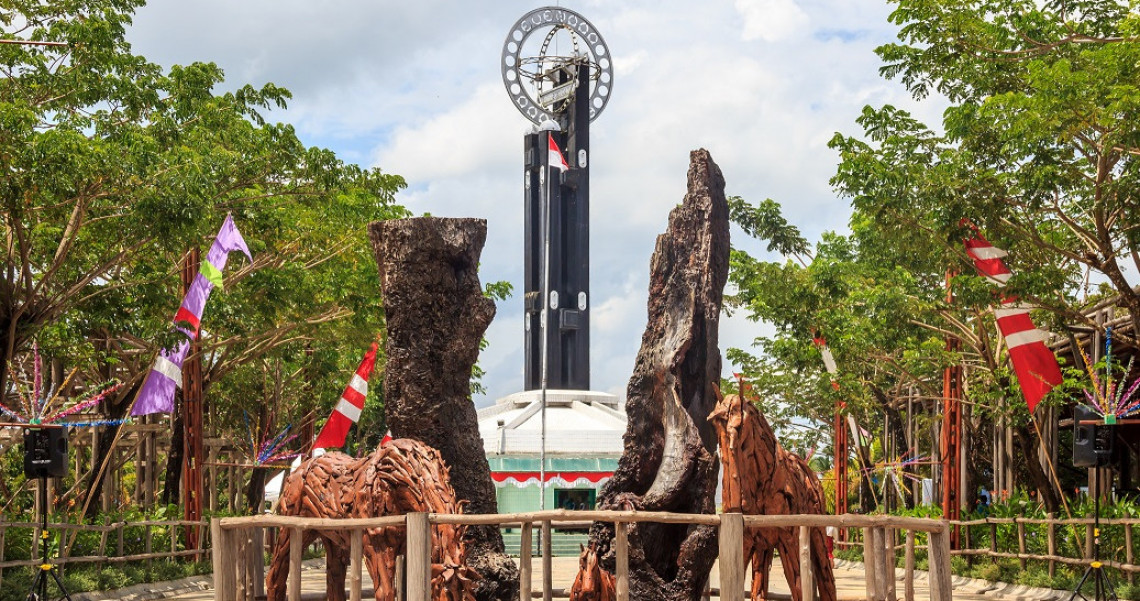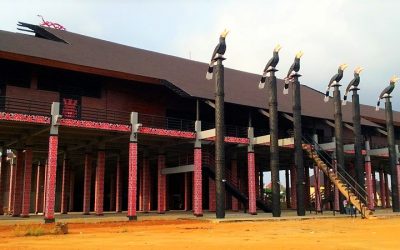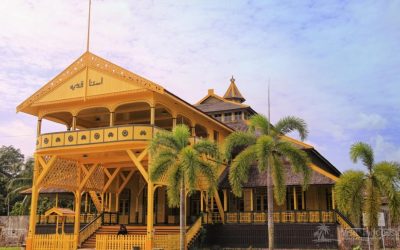Home / Batik Regions – Central Indonesia – Kalimantan Island – West Kalimantan / The Equator Monument
Natural Destination
Experience the tropical nature!
The Equator Monument
Equatorial Monument in Pontianak City (photo: Pesona Indonesia)
Equatorial Monument
It is the capital city of West Kalimantan, also known as the “Equator Zero”. There are a lot of things that tourists can do in this city, like hiking, visiting the Equator Monument, Baning Forest tourism site, and tasting excellent local dishes. This city is inhabited by three different ethnicities with distinctive cultures, namely Dayak, Malay, and Chinese descendant communities that have blended together over the centuries. Such cultural blends could be seen in its architecture, textile, and gastronomic heritages.
Tourist Attractions in West Kalimantan
Pontianak City
The capital city of West Kalimantan that also known as the “Equator Zero”. Apart from this unique
Betang Traditional House
The Betang house is the traditional Dayak Great House, and it contains a lot of its spiritual and
Kadriah Royal Palace
This is the place if you want to see cultural assimilation through architecture. Located in East Pontianak,
West Kalimantan
Batik Motifs
Dayak Kamang
Kamang motif is generally found in the Dayak tribe shield because it is believed to
Awan Berarak
Awan Berarak is a combination of Dayak motifs and Malay patterns. The word ‘Awan Berarak’ means the
Insang Ikan
Insang refers to the gills of the fish. This is a typical pattern of Malay ethnic who inhabits
Discover
Indonesian
Batik
Motifs
Teguh Bersatu
This batik motif shows the strength of the people of Kupang. It also represents a sense of
Tifa Totobuang
The batik motifs illustrate Maluku’s traditional music instrument called
Lipaq Sabe
Lipaq Saqbe contains a simple geometric classical motif with various flower decorations. This textile is
Gonggong Beruntun
This motif illustrates that a person should maintain a positive attitude and
Pucuk Rebung Riau
Pucuk Rebung symbolizes heart determination in achieving goals, good luck, and
Srimanganti
The name of the Srimanganti motif is derived from Palace’s hallway that connects to
Kawung
The Kawung motif was created by Sultan Agung Hanyokrokusumo (1593 – 1645) as a symbolic gift for
Karawo Mahkuta
Mahkuta refers to Gorontalo’s traditional crown. It represents noble characters of
Gonggong Siput
Gonggong (Strombus Turturella) is one type of sea snail found around
Durian Pecah
Broken Durian motifs depict the foundation of faith. The second half signifies the mastery of
Desa Na Tolu
The Desa Na Tolu characteristic pattern symbolizes the Batak philosophy of existence and
Sido Mulyo
Sidomulyo is one of the classical motifs, which is specifically used for the bride’s costume in
Wirasat
Wirasat or divine inspiration is a gift from God. This inspiration is symbolized by
Lontara
The Lontara script itself is a typical ancient script of Bugis and Makassar communities. History records that
Tubo Kelapa
Coconut tree is a symbol of a good character and strong mentality. It illustrates the more success a person, the more
Pattimura
Pattimura is the name of an Indonesian hero who fought against colonialism in
Gajah Way Kambas
The motif illustrates the Lampung’s natural reserve, the Way Kambas. it also symbolizes
Bintik Tujuh
The Bintik Tujuh (Seven Dots) motif has 7 white spots and green color gradation as
Hiu Taliyasan
Indonesia is also home to the world’s largest fish, the whale shark (Rhincodon typus). Hiu Taliyasan refers to
Besurek Rembulan
This batik illustrates praise for God who created the wonderful universe
Enggang Dayak
Local people beliefs that hornbills are an incarnation of the Commander of the Birds. It has supernatural
Tikar Natuna
The Tikar Natuna motif is adapted from the traditional making of pandanus mats in
Tabir Tanjung
Tanjung flower is a type of Cherry tree flower, which is commonly found in
Burung Bidadari
Bidadari birds are endemic birds in Halmahera. This motif represents an
Salakanagara
Salakanagara batik motif illustrates the first kingdom in the Betawi land
Manguni Minahasa
Manguni is identified as the symbol of the Minahasa people. Manguni is known as a
Singayaksa
The Singayaksa motif comes from the name of a place where Sultan Hasanuddin used to
Kerawang Tegak Aceh
The Vertical Upright (Kerawang Tegak) Motif symbolizes a person who has a strong
Awan Berarak
Awan Berarak is a combination of Dayak motifs and Malay patterns. The word ‘Awan Berarak’ means the
Tengkawang Ampiek
With its many advantages, the Dayaks use this leaf in ritual ceremonies. This plant is a symbol of
Daun Sirih
This motif illustrates betel leaves that are used by Lombok communities as traditional
Gigi Haruan Lidi
The Gigi Haruan Lidi motif is taken from the name of the cork fish and is a symbol of
Bale Lumbu
This motif signifies the welfare of the ancient Sasak society. Bale also symbolizes the
Tangerang Herang
Tangerang Herang motif is a symbol of Tangerang city. The Tangerang Herang batik motif consists of
Mahkota Siger
Siger is the crown of a noblewoman in ancient time. It is a symbol of femininity, strength, and
Pati-Pati Pinehiku
It symbolizes the hierarchy in society and the social status of the Mekongga
Gorga Simeol-Meol
The Gorga Simeol-meol is a pattern of plant tendrils. it is regarded as a symbol of longevity and
Jumputan Bintang
The word Jumputan means the tie-dye technique, while the word “Bintang” refers to
Sero Tangga
The Sero Tangga illustrates an endearing feeling and sacrifices of a person to fulfil
Paqbarre Allo
The word “Barre” means round and “Allo” means the sunlight. This motif is interpreted as
Keluak Daun Pakis
The word “Keluak” is a Minang language which means twisted or tangled. The Motif of
Pinawetengan
The Pinawetengan Batik pattern was taken from a prehistoric inscription in
Malinau Cultural Festival
You will witness a unique competition that might not be found other than in
Leuit Sijimat
This motif reflects the daily activities of the Baduy tribe in Banten. The main ornaments of batik motif consist of:
Tampuk Manggis Sasirangan
The motif illustrates the philosophy of the mangosteen fruit, which is
Wakatobi
It symbolizes the coastal beauty of the Wakatobi island and the symbol of Patra symbolizes
Sekomandi
Its philosophical meaning is the eternal union which refers to a saying “until death do us part”
Angsa Duo
According to legend, the Angso duo batik motif is a pair of swans that are believed to have led Princess
Prada Papua
The word “Prada” in the Javanese-Indonesian dialect means a batik textile that
Besurek Rafflesia
The term “Basurek” refers to a textile that contains letters or inscriptions
Gentala Arasy
Built as high as 80 meters, the tower also highlights the historical side of
Kaganga Tanah Rejang
If Batik Besurek combines Arabic calligraphy motifs, then the Kaganga batik takes
Kuda Kupang
Horses symbolize wealth. It contains noble values of virtuous characters that bring
Insang Ikan
Insang refers to the gills of the fish. This is a typical pattern of Malay ethnic who inhabits
Daun Lada Hitam
The black pepper motif represents the main commodity of Bangka Belitung
Lok Baintan Floating Market
As you can imagine, the most authentic thing is that you can buy things and even
Kain Cual
Cual textile tradition has existed since the 17th century. The word “Cual” refers to
Rumah Mamuju
the Batik motif illustrates the house of Mamuju King with the stairs, located on the left of the wooden stage house
Tenun Bima
The motifs are adopted from Bima woven textile. This pattern has received a great
Parang Rusak
Another meaning behind this motif is an unconquerable spirit, symbolized by
Tongkonan
Toraja’s traditional house is called Tongkonan. Tongkonan is a place for
Raja Ampat
Raja Ampat motif represents the marine life at Raja Ampat archipelago in
Biji Kopi
The coffee seeds motif illustrates the pride of local coffee specialities in
Gedhog Kembang Waluh
a combination of Javanese cultural motif of the Majapahit kingdom (XII-XIV century) with
Honai
The Honai is inspired by the traditional house of the Papuan community living in
Kaharingan
The Kaharingan or ‘tree of life’ based on the Dayak tribes’ belief system. This tree symbolizes
La Galigo
La Galigo is a literary work of the Buginese Epic that has 300 thousand epic lines. It is considered even
Merak Ngeram
The hatching peacock motif has a very deep meaning which refers to the sacrifice and
Ake Patra
Ake is related to the divinity and the composition of the universe. It is a symbol of
Sandeq
Sandeq Boat is a symbol of the maritime importance of the West Sulawesi region. The greatness of




